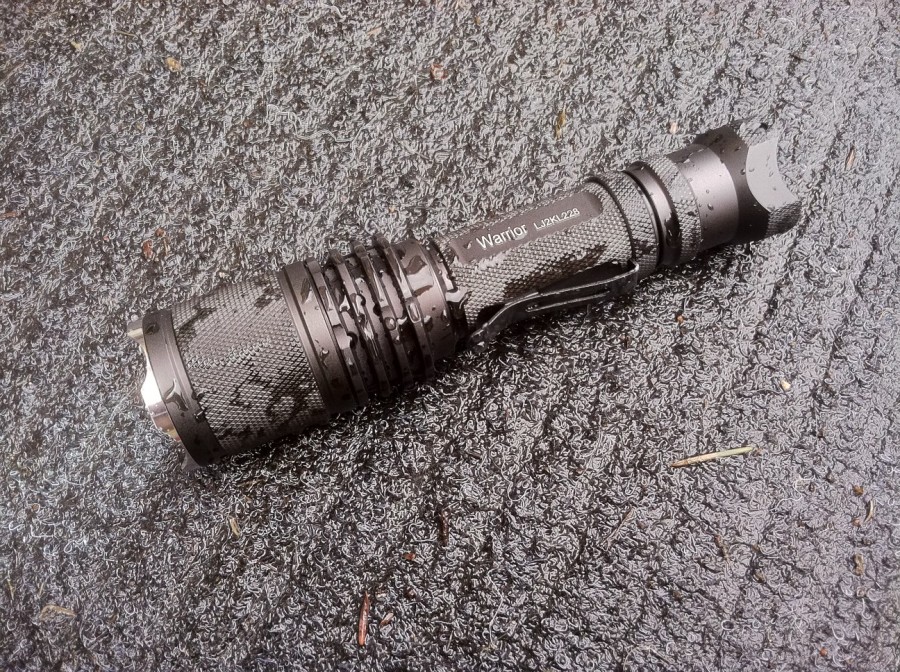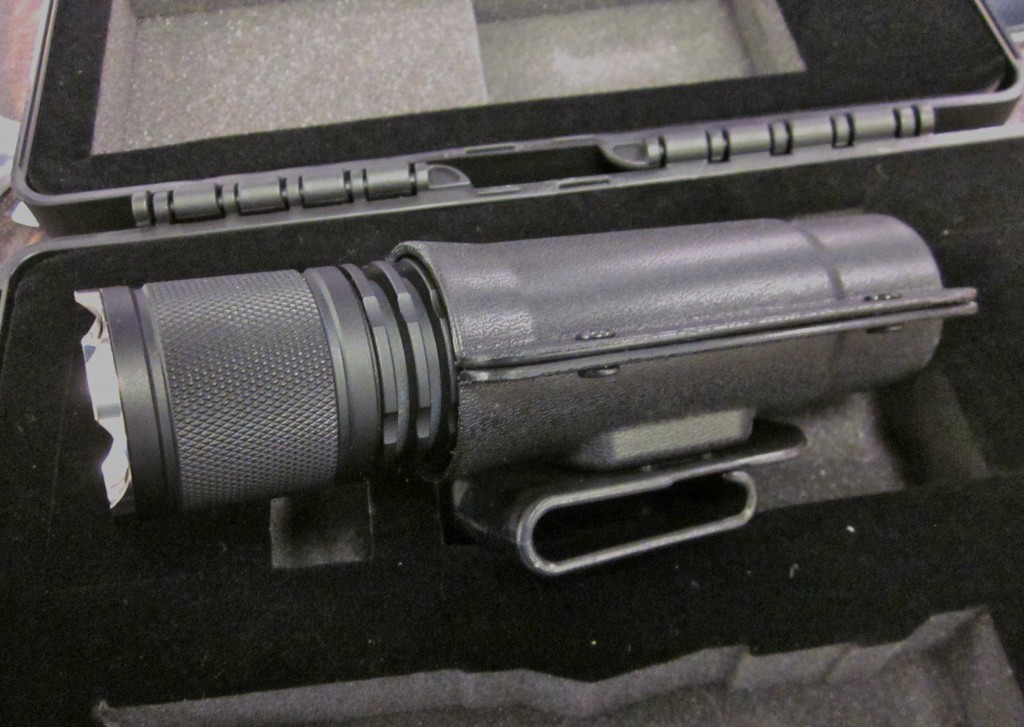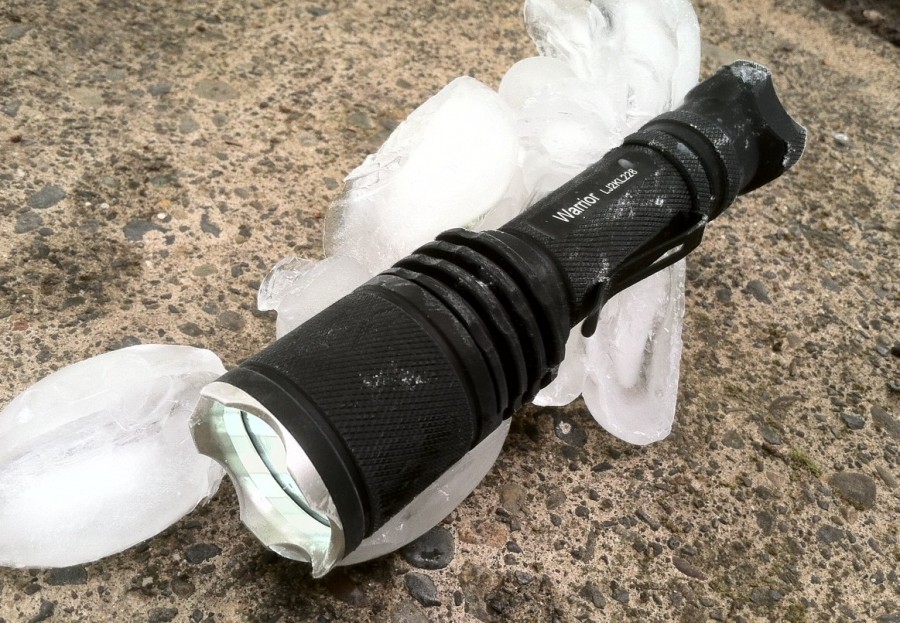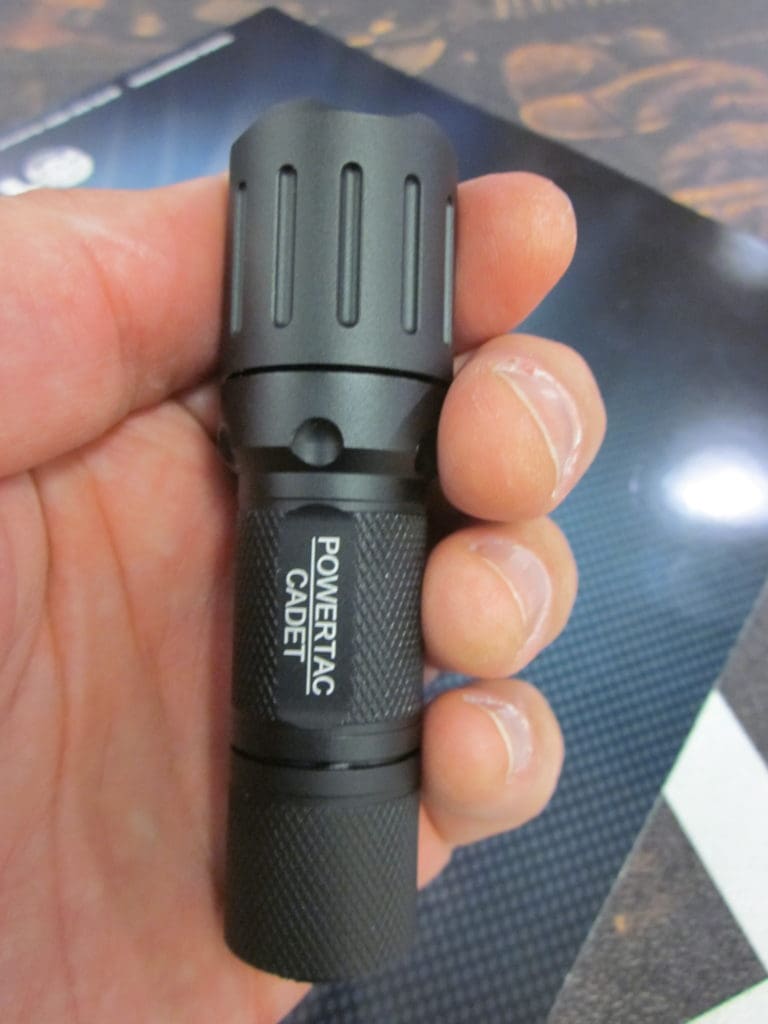 “The light that shines twice as bright burns half as long,” Dr. Eldon Tyrell tells doomed (but still deadly) android Roy Batty in Blade Runner. This rule may hold true in the fractured universe of Philip K. Dick, but does it govern the world of tactical flashlights? Blasting out 650 advertised lumens from two standard lithium batteries, the PowerTac Warrior puts this dictum to the test . . .
“The light that shines twice as bright burns half as long,” Dr. Eldon Tyrell tells doomed (but still deadly) android Roy Batty in Blade Runner. This rule may hold true in the fractured universe of Philip K. Dick, but does it govern the world of tactical flashlights? Blasting out 650 advertised lumens from two standard lithium batteries, the PowerTac Warrior puts this dictum to the test . . .
‘Way back in January, I picked up a pair of PowerTac LED flashlights for testing at the SHOT Show. That was months ago, and I feel a little guilty that it’s taken me so long to wring them out and write them up. Some of that was my fault (so many guns to test, so little time) and some of it wasn’t, so let’s get to it.
Features/Ergonomics
The Warrior is a pretty big flashlight: six inches long and seven ounces loaded. The heavily knurled barrel is one inch in diameter (to fit standard weapon light mounts) and the bezel is 1.5 inches wide. The chromed bezel and anodized tailcap are both crenelated for use as striking weapons or window breakers. They’re not so sharp as to rip through your pocket lining, but if you jab somebody in the melon with it you’ll core out a jumbo-sized DNA sample from their forehead. Ouch.
I used its spring steel pocket clip to carry it around Las Vegas for a few days. This taught me that it’s a little too big for trouser-pocket carry, but it fits handily in cargo pockets or most jacket pockets. It will add more than a half-pound to your carbine, but its amazing brightness would be extremely useful for nighttime pest or hog hunting.
Functions/Controls
The on-off switch is on the tailcap, and it’s recessed slightly so the light can stand upright on its tail. The Cree XM-L LED emitter has five functions, but the tailcap on/off switch doesn’t go in for any of the funny business: it just turns the light on and off. (The Rabbi should approve.) It clicks audibly when fully depressed, but I like that a partial press turns it into a silent momentary on/off switch.
Switching between the five modes, ‘Firefly’, ‘Low’, ‘Bright’, ‘Insanely Bright’, and ‘Seizure Strobe’ (I made some of those up) is done using the strobe/selector switch. This is a smaller button on the side of the tailcap, right under your index finger when the on/off switch is under your thumb. These two buttons are well-positioned for one-handed control of all the light’s functions.
When the light is on, the strobe/selector cycles through the five power settings in order, and it remembers its setting when turned off. When powered off, the strobe/selector button functions as a silent momentary trigger for the ‘Seizure Strobe’: a rapid 650 lumen strobe that will rock your retinas like a rave-partyer’s rucksack full of extasy-flavored Disco Biscuits. If you shine it at a bright surface at close range, your dark-adapted vision will be gone for weeks. Okay, I exaggerate. A little.
Accessories
 In addition to a lanyard and an extra set of O-rings, most Warrior kits come with a sturdy Kydex belt holster. It’s adjustable for snugness and cant, and covers the tailcap switch to prevent accidental activation.
In addition to a lanyard and an extra set of O-rings, most Warrior kits come with a sturdy Kydex belt holster. It’s adjustable for snugness and cant, and covers the tailcap switch to prevent accidental activation.
Brightness
Confession: I have no technical means of testing how many lumens any flashlight produces. I’m something of a flashlight junkie, however, and the Warrior is by far the brightest flashlight I’ve ever handled. Side-by-side at full power, it profoundly outshines a 280-lumen Ulzio R-1 rechargeable LED light, and absolutely blows away a 120-lumen Coast Tactical LED.
 This slightly off-center photo shows the Warrior’s huge, dazzling hotspot and even more enormous splash area. The 280-lumen Ulzio beam is tightly focused in the middle, with a slightly dimmer hotspot and very little splash illumination. The 120-lumen Coast Tactical is on the right, with an ever smaller (and dimmer) hotspot, but a useful splash area.
This slightly off-center photo shows the Warrior’s huge, dazzling hotspot and even more enormous splash area. The 280-lumen Ulzio beam is tightly focused in the middle, with a slightly dimmer hotspot and very little splash illumination. The 120-lumen Coast Tactical is on the right, with an ever smaller (and dimmer) hotspot, but a useful splash area.
Mounted to a weapon, the Warrior’s brilliant hotspot will illuminate and clearly identify your targets out to 75-100 yards, and probably blind them at closer ranges. For indoor use, you’ll want to set this phaser on ‘Stun’ (medium brightness) so you don’t dazzle yourself with the reflection from nearby light-colored surfaces.
Battery Life
Was Dr. Eldon Tyrell right about the Warrior? I ran it to exhaustion with a set of new Energizer CR123 batteries to find out. I had to do it in ten-minute segments, because it gets pretty warm after five minutes. After fifteen minutes it was almost too hot to pick up. I haven’t noticed this with other flashlights which barely pump out half the light the Warrior does. I dropped out of the electrical engineering program in college (too much math) but I seem to recall that you can’t turn that many electrons into photons without producing a lot of heat in the process.
It took me a while to test, but a fresh set of CR123s powered the Warrior for a bit over 60 minutes of extreme brightness. After that first hour or so the brightness dims slightly, and the light stops heating itself up as much. It keeps shining at this level (still really bright) for another 25 minutes, the automatically switches to a dimmer setting as the battery fades away.
All in all, I’d say that PowerTac’s claim of 78 minutes at full power is essentially correct, although the brightness takes a small hit after the first hour.
I didn’t test the Warrior’s battery life at its lower power settings. PowerTac advertises that it will run for 2.5 hours at Medium brightness (which at a claimed 350 lumens is still brighter and longer than most tactical lights on the market), 13 hours at Low, and 60 hours at its dimly glowing ‘Firefly’ setting.
Some Warrior kits come with a Li-ion 18650 battery and charger, and these can save you beaucoups of dollars if you use your flashlight a lot. Our tester worked fine with a 18650 cell that I pulled from the Ulzio R-1, but the runtime will be shorter because of its smaller battery capacity (2000 mAh, vs. 2600-2800 mAh for disposable CR123 batteries). With CR123 batteries running at least $2 each, I won’t mind the slight inconvenience.
Ruggedness/Reliability
The Warrior has a badass appearance, and it’s not just false advertising. Every thread and switch is O-ring sealed for water protection and it’s described as waterproof, although PowerTac advised me that it’s not intended for extended immersion. Mine didn’t seem to mind: I left it running at the bottom of the full kitchen sink for about ten minutes during the battery test, and didn’t have to worry about it overheating. (Insert ‘heat sink’ pun here; I’m fresh out)
 I also froze the Warrior until it became one with the contents of my automatic icemaker. I didn’t try to freeze it solid (no flashlight will work when the batteries are frozen) but I wanted to see how it would perform in snow or cold weather. It works fine. And yes, that’s frost on it.
I also froze the Warrior until it became one with the contents of my automatic icemaker. I didn’t try to freeze it solid (no flashlight will work when the batteries are frozen) but I wanted to see how it would perform in snow or cold weather. It works fine. And yes, that’s frost on it.
It doesn’t seem to mind being repeatedly dropped onto concrete from 3-4 feet. It got some scratches because concrete is harder than aluminum, but it didn’t dent and nothing broke. The threaded bezel shook itself slightly loose after a dozen or so drops, but easily re-tightened.
Disclosure:
The first Warrior sample I picked up in January stopped functioning after about a day of intermittent use. I never learned what the problem was, but it was promptly replaced by PowerTac, and I’ve been testing this replacement light since January. All PowerTac lights come with a ‘No Hassle’ lifetime warranty in any case.
Summary
The PowerTac Warrior is about the same size as many other big tactical lights, but it’s in a class by itself when it comes to brightness. Battery life is predictably short at maximum power, but the 2.5 hour runtime at medium power is better than average for its 300-lumen brightness. Even that ‘medium’ setting is still brighter than almost any Surefire or Streamlight of comparable size or cost.
My use and abuse has shown it to be solid, rugged and unbelievably bright, and it earns a Recommended rating.
Price: $125-165 actual, depending on accessories.
BUT WAIT…THERE’S MORE!
Bonus Mini-Review: PowerTac Cadet LED Flashlight
 The 300-lumen Cadet is the Warrior’s baby brother. This tiny $69 flashlight is just a little bigger than your thumb and weighs only 2.7 ounces loaded. It’s exceptionally bright for its small size, completely waterproof (even for extended immersion) and rugged as all get-out. It’s powered by a single CR123 battery, and it’s been my EDC companion since January. I absolutely love it.
The 300-lumen Cadet is the Warrior’s baby brother. This tiny $69 flashlight is just a little bigger than your thumb and weighs only 2.7 ounces loaded. It’s exceptionally bright for its small size, completely waterproof (even for extended immersion) and rugged as all get-out. It’s powered by a single CR123 battery, and it’s been my EDC companion since January. I absolutely love it.
It has an on-off tailcap switch and five power settings. The crenelated bezel switches it to a strobe whenever it’s loosened, and then cycles it to the next power setting in order (‘Moonlight’, low, medium, high and strobe) when re-tightened. This user interface isn’t the best I’ve ever seen since it requires two hands, and there are many times when you don’t want a 300-lumen strobe even for a few seconds. Still, it keeps the light mechanically simple, and this makes it waterproof for extended immersion.
I noticed that the ‘low’ power setting is actually a dim but extremely rapid strobe which produces a beautiful scintillating effect at night in a snowstorm. Not that you’ll use it much for that particular purpose.
The front bezel is 1″ in diameter, much wider than the body itself. This makes it compatible with most standard weapon mounts, and PowerTac sells a $16 remote pressure switch that replaces the tailcap.
The Cadet has a pocket clip for bezel-up carry, and it clips to the bill of a baseball cap perfectly for hands-free chores. Don’t leave it on at full power for extended periods, because it doesn’t have much of a heat sink and it gets hot to the touch in five minutes.
I didn’t test the Cadet for battery life, although I’d note that it’s been running the same CR123 battery since late January. According to PowerTac (who proved pretty truthful about the Warrior’s battery life) it will run for one hour at max brightness, 130 minutes at medium brightness, and ten hours on low. It will run all night for a week and a half at the lowest ‘Moonlight’ setting.
UPDATE (5/30/12)
PowerTac’s president emailed me with a correction/update I’m glad to pass along: my sample Cadet was an older design, and the new design has been upgraded with a momentary on/off tailcap switch. Presumably this switch is silent (I’ve yet to see a clicky momentary switch on any flashlight outside of Costco) and if so this perfectly addresses my only criticism about the Cadet.
The Cadet is Strongly Recommended for its tiny size, ruggedness, brightness and reasonable price. I loved the older model, and I like the newer model even more.





Nice light, but I can’t justify a $125 flashlight, so I guess I’ll stick to my Maglites.
you can get the equivaliant on ebay for around $25.00 made in china…yes…but so is this
Let me know how long that $25 Ebay light last, because I’ve bought a few and they don’t last or have warranty. I’m a strong believer in, you get what you pay for. I use the Powertac Gladiator on duty and I think it’s a great product for the money.
Your name is Ready Fire Aim? FLAME DELETED
I agree with Lawman47 that a $25 light is not going to cut it for mission critical professionals like police officers and soldiers, but unbelievably so many people like the guy who aim after shoot would go cheap to risk their lives.
Picked up this tip from watching the incomparable Clint Smith of Thunder Ranch fame. These handheld lights are great but with only two hands and ten fingers on them, it helps if you can put a loop of paracord on the lights. When you need the dexterity of all fingers you can drop the hold on the light with a loop around the palm of a hand. Then very quickly snap it up into a secure hold when done with whatever you were doing (e.g. tap and rack, mag change, guiding a loved one in the dark, etc).
Philip K. Dick was one of the giants of science fiction who contributed to the holy cannon of SF writing that most neophytes never approach.
He is one of my favorite authors. Do Androids Dream of Electric Sheep is an impressive story. Man in the High Castle is my personal favorite.
I would really like to see a comparison to some of the Fenix flashlights (PD22 or PD32).
If you want to get good info about flashlights with real objective measurements, I recommend going to the flashaholics…I mean experts.
They also deal with batteries and chargers which are just as important to producing light.
I read a lot before getting some flashlights of my own. Ended up with O-light for the AR Mounted light. 4-sevens for the pocket light (EDC), EagleTac for the laptop bag/work light, and Shining beam for the farm spotlight.
Here is a link to one of the better sites: http://budgetlightforum.com/
I picked up a PowerTac T2C at my last gun show, about 3 months ago, for $60. It’s a five-mode light, with a max of 280 lumens (with strobe), followed by 65 lumens, 9 lumens, and a 0.09 lumen “firefly” mode.
So far, I’ve mostly used it around the house and for walking the dog. It’s probably spent an equal amount of time clicked on at low flashlight (9 lm) intensity and momentary on at full intensity (280 lm). It’s still running on the first set of batteries, although not for much longer, I think. Light intensity in lithium battery LED lights looks like a waterfall: it goes along at the same level for 90% of the battery life, and then it rolls over an edge and drops like a stone. It doesn’t “hurt” to look at full intensity pointed at the ground any more, so I think my toes are peeking over that edge, and getting ready to fall.
It’s got a nice hotspot, about 9″ at 6′ (3′ splash) expanding to about 27″ at 20′ (~12′ splash), and at full brightness easily lights up the far bank of my lake, about 125 yards away.
It’s 7/8″ in diameter, so it won’t fit standard weapon mounts, but I don’t think it’s really designed to be a weapon light anyway, so I’m not marking off points for that.
I’ve found that five mode lights sound cool, but this light spends 95% or more of its time in either full 280 lm or low 9 lm mode. The firefly mode is neat, but I’ve yet to find myself in a situation where it was dark enough to be useful. 0.09 lumens is really dim, easily overpowered by a full moon and most ambient city light.
The only thing I dislike about it is that it has the “bezel twist” method of mode change, like the reviewed Cadet, which isn’t super convenient. The website also says, “With the head slightly loosened, you get one of five possible modes. Soft-press the switch to advance through Firefly, Low, Medium, High, and Strobe in repeating sequence”, but I’ve not gotten that to work on mine.
All said, it’s a solid flashlight that I’m not sorry I bought for my first “tactical style” flashlight. I would prefer a different mode selection, but that’s my only gripe. It will serve nicely until I get my holy grail Surefire M3LT.
Hrm… so I wrote up this nice 4-5 paragraph comment about my PowerTac flashlight, and when I hit post, I got this cool new gray bar overlay at the top of my screen that said, “Posting comment…” After a couple seconds, the bar turned green and said, “Comment successfully posted!” However, despite clearing my cache and refreshing the page, my comment isn’t here and I received no subscription email. I’m really sad because I’d gotten out of the habit of copying my comment in case of an error prior to hitting Post.
Halp.
And of course, the comment about my comment went right up, correctly. Grrr.
I feel your pain. Mobile comments are still a hit-miss affair too. Farago is still trying to get the non-mobile Comments problems worked out. The switch to Go Daddy really f-ed everything up, and the dimensions of the problem are just starting to be known.
I have researched many single AAA battery lights and owned a few too. Out of what I’ve come across the Fenix LD01 is the best! This is a solid light that provides great throw, battery life, and compact design. This thing took a trip through the laundry cycle and still worked like brand new. The inside of the dryer took more of a beating than the light did. This is the first light I grab for hiking, camping, and backpacking trips. I like how the light consists of only 2 main pieces; the head and the body. This means there’s only one gasket to worry about. I’ve noticed that when using alkaline batteries the high beam stops functioning once the battery gets low. I’ve since switched to ultimate lithiums and have not had a problem since. I also recommend purchasing it from a reputable source like REI because there are a lot of shady electronics dealers on the internet that will sell you last year’s model in this year’s packaging. Plus, if you get a faulty product, you’ll have no problem exchanging it. When it comes to flashlights, you get what you pay for. You won’t be disappointed with this light!
Just say no to cr123a batteries. http://jesusnjim.com/cr123.html
I buy AA powered lights and use nimh rechargeable batteries.
http://www.fenixgear.com/flashlight/Fenix_AA_Battery_Series.html
http://www.foursevens.com/light-finder/?gclid=CN2kv4L_prACFWaFQAod1UdIZg
I’m glad not to be the only flashlight junkie here! My other favorite EDC light is a $60 Coast which runs on 3 Ni-mH AAA cells, but it’s so much bulkier than the Cadet. I’d rather that any 2-cell CR123 light be powered by 3 AAAs because the runtime is comparable and the operating cost is so much lower. There are rechargeable CR123s out there, but I haven’t spent the money to try them yet.
Similar to the Thrunite T30, which costs $30-$35 + shipping.
I researched your T30 and it doesn’t strobe. The T30 is a beginners light not a tactical light. It doesn’t have a striking bezel. It only has 3 levels of brightness which is only 530 lumens. It comes with a nylon holster not a kydex holster. You change the functions by twisting the head not one handed operation. They don’t have a US office or offer a lifetime warranty. Also not sure where you got $30-$35 from because the cheapest one I can find online is $60.
http://www.sbflashlights.com/Clearance/Thrunite-T30-p173.html
$34.95 + shipping
http://www.sbflashlights.com/Clearance/Thrunite-T30-p173.html
My E1 has repeatey failed. The O rings had to be re-purchased, break often do to heat, and switching settings ALWAYS brings up strobe result. I HEAR OF A LIFETIME WARRANTY but can’t find anyone to call to explain this issue which is ULTRA FRUSTRATING!!! My E5 works flawlessly and I can’t even comment on its awe and splendor. I feel cheated on my E1!!! IS THERE “REALLY” A WAY TO GET AN E1 THAT WORKS? RICK RUTTER. 724 E 5th. Lancaster OH. 43130. 740 407 4444
I have had an E5 for about 2 years. I use it often and it has never failed. The brightness and range is incredible and many whom have seen my light have said that they intended to buy one. Very impressive light for the money.
Comments are closed.